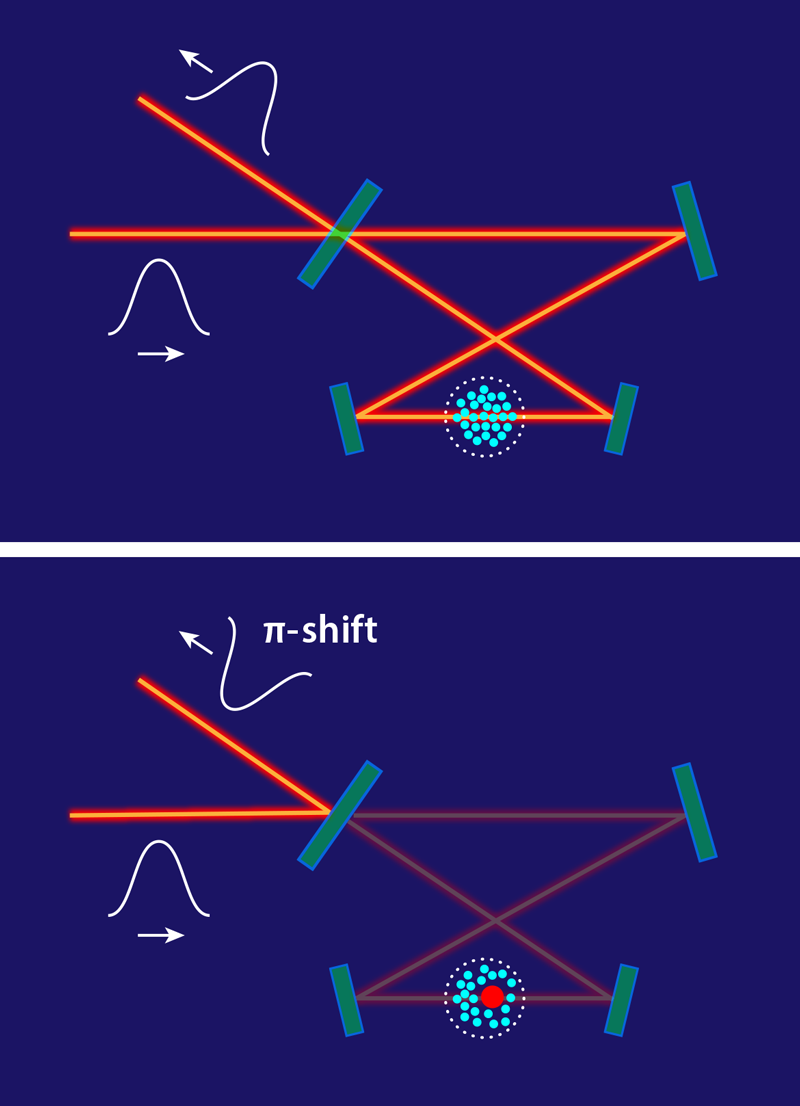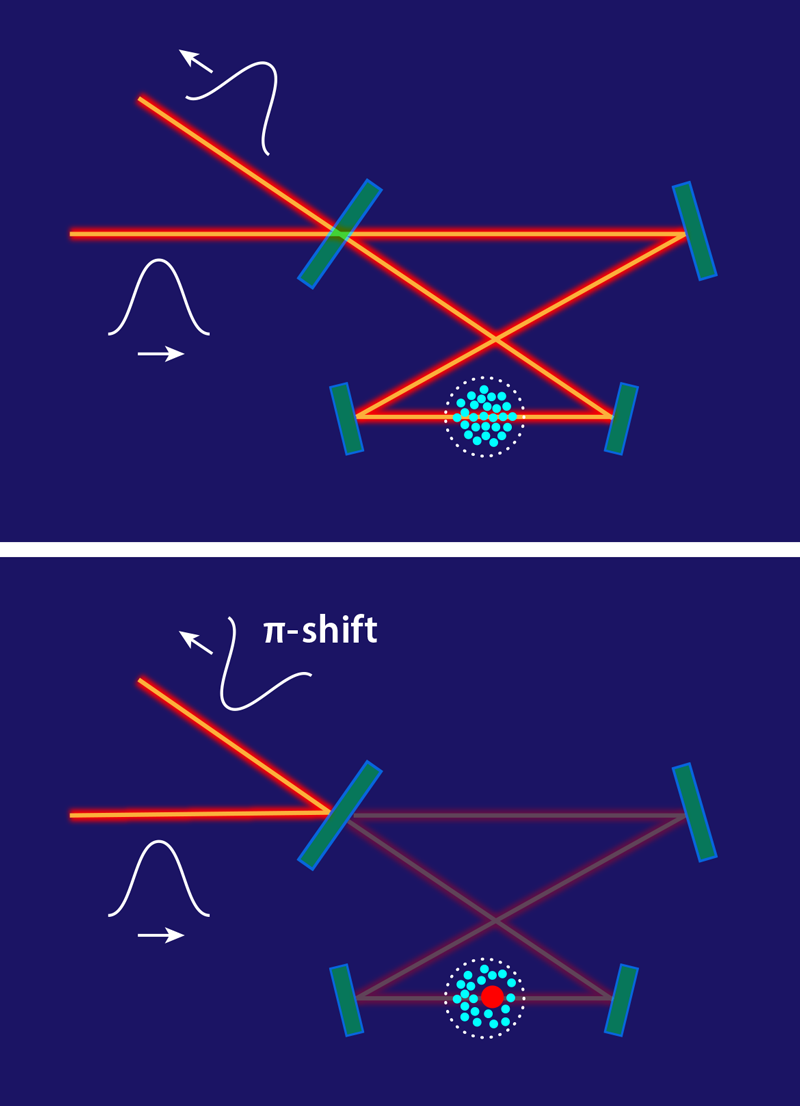Controlling Single Photons with Rydberg Superatoms
The past decade has witnessed swift progress in the development and application of quantum technologies. Many promising directions involve using photons, the smallest energy packets of light, as carriers of quantum information [1]. Photons at optical wavelengths can be quickly transported through optical fibers over long distances and with negligible noise, even at room temperature. Unfortunately, one drawback is that photons do not normally interact with each other, which makes it challenging to manipulate a photon with another photon. Optical photons also couple weakly with other quantum systems, such as superconducting qubits, which makes it hard to interface these platforms with photons. Now, two research groups, one led by Alexei Ourjoumtsev at PSL University, France, and the other by Stephan Dürr and Gerhard Rempe at the Max Planck Institute for Quantum Optics, Germany, demonstrate all-optical schemes for realizing operations on photons [2, 3]. The schemes hold potential for building components for both photonic quantum computers and quantum networks.
To achieve the desired controllable interactions between individual photons, a physical platform is required that exhibits an extremely large optical nonlinearity, such that its optical response is different for one and two photons. Individual atoms, in principle, exhibit a large nonlinearity due to an effect called saturation (one atom can only absorb one photon at a time). However, the coupling between a single atom and a single photon is weak, meaning that a deterministic manipulation of the photons is impossible—a logic device would have a less-than-certain probability of performing its function.
Recent attempts to enhance this coupling involve the use of a high-quality optical cavity, where a photon bouncing between the mirrors has a chance to interact multiple times with an atom placed inside the cavity [4]. However, sizable coupling enhancements require extremely high-quality mirrors and cavity stabilization schemes, which are technically challenging to realize. These challenges have so far limited the coupling strength achievable with individual atoms.
A second approach is to generate an artificial, two-level atom comprising many atoms—a superatom. One such scheme involves Rydberg atoms, which have one of their outermost electrons excited to a state with a large principal quantum number, and which can interact strongly with each other over micrometer scales [5]. This strong interaction means that, in an ensemble of atoms, the excitation of one atom to a Rydberg state can block the Rydberg excitation of a second atom, permitting the absorption of only one photon at a time. Under these conditions, the whole ensemble acts like a superatom, in which the transition between ground and excited states has a giant cross section for the absorption of a photon. However, if too many atoms are packed into a small volume, atomic collisions will cause the dephasing of the quantum coherence between the two superatom states. Such dephasing limits the maximum density of the atoms and thereby the achievable atom-photon coupling strength [6].
To overcome these limitations, the teams combine the two approaches, placing a Rydberg superatom inside an optical cavity. In both studies, the researchers use light beams to coherently manipulate the state of the superatom inside the cavity. They then show that, depending on the state of the superatom, the optical cavity manifests different optical responses (Fig. 1). If the superatom remains in its ground state, photons can pass through the cavity, which displays high transmission. But if the superatom is in its excited Rydberg state, photons cannot enter the cavity and will be reflected at its entrance port. Upon reflection, the optical phase of each photon will be shifted by 𝜋. Therefore, this 𝜋-phase shift can be controlled by switching the superatom’s state.
The two studies show that the superatom-cavity system displays features that enable reliable and efficient control over photons. First, the superatom’s state inside the optical cavity can be determined nondestructively by monitoring photon transmission through the cavity. Ourjoumtsev’s group demonstrates that such nondestructive detection can be obtained in a single shot with a 95% fidelity [2]. A fast and nondestructive detection would be crucial for implementing quantum error correction. Second, the 𝜋-phase shift that is conditional on the superatom state can be harnessed to realize an important logical component for quantum operations: a controllable two-qubit gate.
Dürr and Gerhard’s group experimentally demonstrates one such gate—a CNOT gate that switches one qubit’s state if and only if the other qubit is in its “1” state [3]. This demonstration was a true tour de force that eliminated many imperfections that can lead to the loss of the control or target photons. As a result, the demonstrated gate features a record-high efficiency of over 40% (efficiency is defined as the probability that the gate performs its operation), a value more than 3 times larger than the previous record of 11%. Gate efficiency is a key bottleneck for the development of photonic quantum computation. Low efficiency means that additional hardware and operations are needed to ensure the operation is accurately executed. The breakthrough in efficiency demonstrated here would thus significantly reduce the overhead needed for reliable quantum computation.
Together, the results by the two groups encourage the exploration of similar concepts that could be used in optical quantum-computing schemes. Beyond its computation potential, the efficient and precise control over photons achieved with this Rydberg superatom-cavity platform constitutes an important step toward realizing high-speed quantum-communication networks based on photons exchanged through conventional optical fibers. In such networks, the cavity-superatom system could serve as a quantum memory or as an optical switch that preserves quantum coherence.
Finally, the new system may be used as a transducer that connects different quantum-information platforms. Such transduction could be realized by connecting the transition between ground and Rydberg states, which typically lies at optical frequencies, with transitions between the many Rydberg states for an atom, which lie in the microwave range from a few GHz to 100 GHz. As such, Rydberg superatoms could be employed to coherently convert microwave photons into optical photons and vice versa. This functionality opens pathways toward new hybrid quantum technologies that transduce quantum information between optical and microwave photons, which can couple, respectively, to atomic qubits and to superconducting qubits.
References
- T. E. Northup and R. Blatt, “Quantum information transfer using photons,” Nat. Photonics 8, 356 (2014).
- J. Vaneecloo et al., “Intracavity Rydberg superatom for optical quantum engineering: Coherent control, single-shot detection, and optical 𝜋 phase shift,” Phys. Rev. X 12, 021034 (2022).
- T. Stolz et al., “Quantum-logic gate between two optical photons with an average efficiency above 40%,” Phys. Rev. X 12, 021035 (2022).
- A. Reiserer and G. Rempe, “Cavity-based quantum networks with single atoms and optical photons,” Rev. Mod. Phys. 87, 1379 (2015).
- M. D. Lukin et al., “Dipole blockade and quantum information processing in mesoscopic atomic ensembles,” Phys. Rev. Lett. 87, 037901 (2001).
- A. Gaj et al., “From molecular spectra to a density shift in dense Rydberg gases,” Nat. Commun. 5, 4546 (2014).





